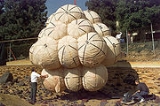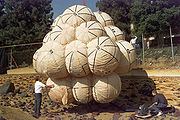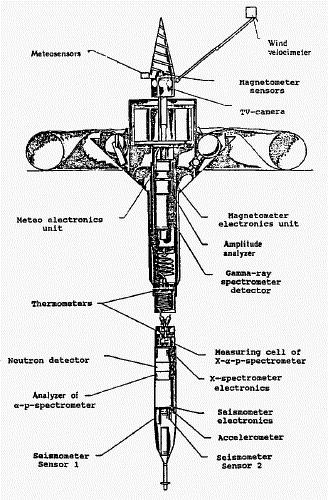
Lithobraking
Encyclopedia
Lithobraking is a technique of descent by an unmanned space vehicle (usually a probe) to the surface of a body by which the vehicle is slowed by impact with the body's surface.
 The word was probably coined as a whimsical adaptation of aerobraking
The word was probably coined as a whimsical adaptation of aerobraking
, which is the process of slowing a space vehicle by the use of friction against a planet
's atmosphere. Lithos is a Greek
word meaning "rock" or "stone."
Preparations for lithobraking involve protecting the probe with sufficient cushioning to withstand an impact with the surface and come to rest undamaged. The Venera
landers used shock absorbers. More recently, airbag
s have been used. Incoming angles are made shallow enough such that the impact has the characteristic of a glancing blow, rather than a direct impact on the surface; it has been speculated that the Beagle 2
lander was destroyed on landing because it struck a vertical cliff at the lip of a crater. In the case of bodies with a sufficiently thick atmosphere (e.g., Mars
), lithobraking is typically accompanied by the use of heat shield
s and parachute
s to reduce the speed prior to impact. The Mars Pathfinder
and Mars Exploration Rover
programs have used this approach successfully.
 Alternatively, the incoming velocity can be used to enable the probe to penetrate the surface.
Alternatively, the incoming velocity can be used to enable the probe to penetrate the surface.
This approach can be tried on bodies with low gravitation, such as comet
s and asteroid
s, or on planets with atmospheres (by using only small parachutes, or no parachutes at all). Several such missions have been launched, including penetrators on the two Phobos probe landers
targeted for Mars' moon Phobos
and ones for Mars itself on Mars 96
and Deep Space 2
, but so far none have succeeded. The cancelled LUNAR-A
probe would have carried penetrators to the Moon
.
Lithobraking as a method for de-orbiting a spacecraft has not been used due to the extremely high orbital velocities of most bodies (e.g. for the Moon it is over 7000 km/h). However, some small moons and asteroids have very low gravity and it could conceivably be used there (e.g. Phobos has an escape velocity
of 40 km/h.)
Certain concepts involve the spacecraft in an orbit tangent to the surface of the body in question, and "docking" with a magnetically levitated
(maglev) train, and the train then slowing. This qualifies as lithobraking, as the reaction mass is the planet itself. This technique requires extremely precise guidance and control, in addition to a large infrastructure, and is thus not yet a viable option - although it may be in the future. An advantage to this method is that it can also launch spacecraft, without needing propellant.
The term is also sometimes used as a euphemism
to describe situations in which lithobraking was not the original desired landing method - i.e., crashes.

Aerobraking
Aerobraking is a spaceflight maneuver that reduces the high point of an elliptical orbit by flying the vehicle through the atmosphere at the low point of the orbit . The resulting drag slows the spacecraft...
, which is the process of slowing a space vehicle by the use of friction against a planet
Planet
A planet is a celestial body orbiting a star or stellar remnant that is massive enough to be rounded by its own gravity, is not massive enough to cause thermonuclear fusion, and has cleared its neighbouring region of planetesimals.The term planet is ancient, with ties to history, science,...
's atmosphere. Lithos is a Greek
Greek language
Greek is an independent branch of the Indo-European family of languages. Native to the southern Balkans, it has the longest documented history of any Indo-European language, spanning 34 centuries of written records. Its writing system has been the Greek alphabet for the majority of its history;...
word meaning "rock" or "stone."
Preparations for lithobraking involve protecting the probe with sufficient cushioning to withstand an impact with the surface and come to rest undamaged. The Venera
Venera
The Venera series probes were developed by the Soviet Union between 1961 and 1984 to gather data from Venus, Venera being the Russian name for Venus...
landers used shock absorbers. More recently, airbag
Airbag
An Airbag is a vehicle safety device. It is an occupant restraint consisting of a flexible envelope designed to inflate rapidly during an automobile collision, to prevent occupants from striking interior objects such as the steering wheel or a window...
s have been used. Incoming angles are made shallow enough such that the impact has the characteristic of a glancing blow, rather than a direct impact on the surface; it has been speculated that the Beagle 2
Beagle 2
Beagle 2 was an unsuccessful British landing spacecraft that formed part of the European Space Agency's 2003 Mars Express mission. All contact with it was lost upon its separation from the Mars Express six days before its scheduled entry into the atmosphere...
lander was destroyed on landing because it struck a vertical cliff at the lip of a crater. In the case of bodies with a sufficiently thick atmosphere (e.g., Mars
Mars
Mars is the fourth planet from the Sun in the Solar System. The planet is named after the Roman god of war, Mars. It is often described as the "Red Planet", as the iron oxide prevalent on its surface gives it a reddish appearance...
), lithobraking is typically accompanied by the use of heat shield
Heat shield
A heat shield is designed to shield a substance from absorbing excessive heat from an outside source by either dissipating, reflecting or simply absorbing the heat...
s and parachute
Parachute
A parachute is a device used to slow the motion of an object through an atmosphere by creating drag, or in the case of ram-air parachutes, aerodynamic lift. Parachutes are usually made out of light, strong cloth, originally silk, now most commonly nylon...
s to reduce the speed prior to impact. The Mars Pathfinder
Mars Pathfinder
Mars Pathfinder was an American spacecraft that landed a base station with roving probe on Mars in 1997. It consisted of a lander, renamed the Carl Sagan Memorial Station, and a lightweight wheeled robotic rover named Sojourner.Launched on December 4, 1996 by NASA aboard a Delta II booster a...
and Mars Exploration Rover
Mars Exploration Rover
NASA's Mars Exploration Rover Mission is an ongoing robotic space mission involving two rovers, Spirit and Opportunity, exploring the planet Mars...
programs have used this approach successfully.

This approach can be tried on bodies with low gravitation, such as comet
Comet
A comet is an icy small Solar System body that, when close enough to the Sun, displays a visible coma and sometimes also a tail. These phenomena are both due to the effects of solar radiation and the solar wind upon the nucleus of the comet...
s and asteroid
Asteroid
Asteroids are a class of small Solar System bodies in orbit around the Sun. They have also been called planetoids, especially the larger ones...
s, or on planets with atmospheres (by using only small parachutes, or no parachutes at all). Several such missions have been launched, including penetrators on the two Phobos probe landers
Phobos program
The Phobos program was an unmanned space mission consisting of two probes launched by the Soviet Union to study Mars and its moons Phobos and Deimos. Phobos 2 became a Mars orbiter and returned 38 images with a resolution of up to 40 meters...
targeted for Mars' moon Phobos
Phobos (moon)
Phobos is the larger and closer of the two natural satellites of Mars. Both moons were discovered in 1877. With a mean radius of , Phobos is 7.24 times as massive as Deimos...
and ones for Mars itself on Mars 96
Mars 96
Mars 96 was a failed Mars mission launched in 1996 to investigate Mars by the Russian Space Forces and not directly related to the Soviet Mars probe program of the same name. After failure of the second fourth-stage burn, the probe assembly re-entered the Earth's atmosphere, breaking up over a...
and Deep Space 2
Deep Space 2
Deep Space 2 was a NASA probe which was part of the New Millennium Program. It included two highly advanced miniature space probes which were sent to Mars aboard the Mars Polar Lander in January 1999. The probes were named "Scott" and "Amundsen", in honor of Robert Falcon Scott and Roald Amundsen,...
, but so far none have succeeded. The cancelled LUNAR-A
LUNAR-A
LUNAR-A is a cancelled Japanese spacecraft project that was originally scheduled to be launched in August 2004. After many delays LUNAR-A is a cancelled Japanese spacecraft project that was originally scheduled to be launched in August 2004. After many delays LUNAR-A is a cancelled Japanese...
probe would have carried penetrators to the Moon
Moon
The Moon is Earth's only known natural satellite,There are a number of near-Earth asteroids including 3753 Cruithne that are co-orbital with Earth: their orbits bring them close to Earth for periods of time but then alter in the long term . These are quasi-satellites and not true moons. For more...
.
Lithobraking as a method for de-orbiting a spacecraft has not been used due to the extremely high orbital velocities of most bodies (e.g. for the Moon it is over 7000 km/h). However, some small moons and asteroids have very low gravity and it could conceivably be used there (e.g. Phobos has an escape velocity
Escape velocity
In physics, escape velocity is the speed at which the kinetic energy plus the gravitational potential energy of an object is zero gravitational potential energy is negative since gravity is an attractive force and the potential is defined to be zero at infinity...
of 40 km/h.)
Certain concepts involve the spacecraft in an orbit tangent to the surface of the body in question, and "docking" with a magnetically levitated
Magnetic levitation
Magnetic levitation, maglev, or magnetic suspension is a method by which an object is suspended with no support other than magnetic fields...
(maglev) train, and the train then slowing. This qualifies as lithobraking, as the reaction mass is the planet itself. This technique requires extremely precise guidance and control, in addition to a large infrastructure, and is thus not yet a viable option - although it may be in the future. An advantage to this method is that it can also launch spacecraft, without needing propellant.
The term is also sometimes used as a euphemism
Euphemism
A euphemism is the substitution of a mild, inoffensive, relatively uncontroversial phrase for another more frank expression that might offend or otherwise suggest something unpleasant to the audience...
to describe situations in which lithobraking was not the original desired landing method - i.e., crashes.

